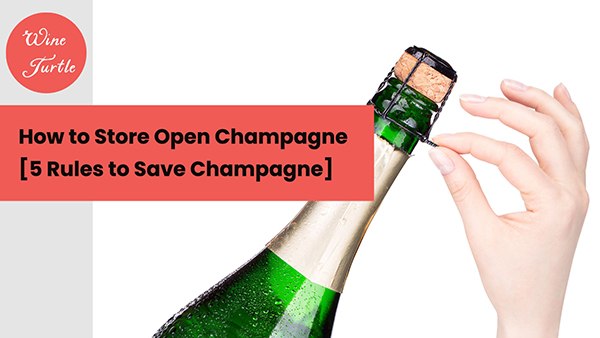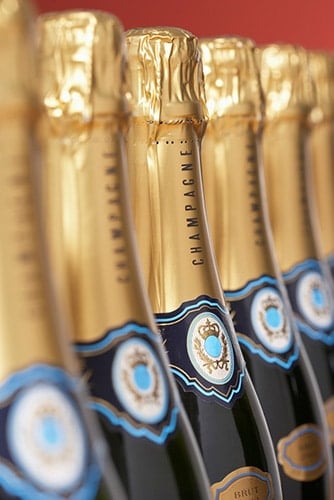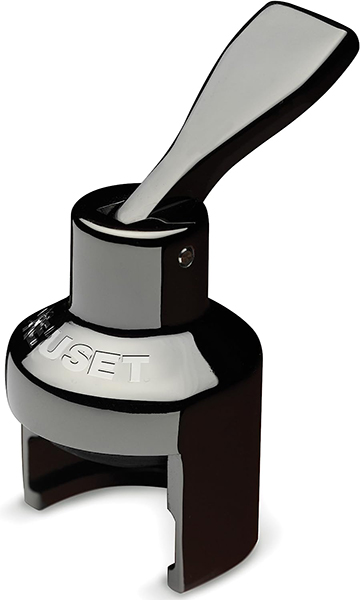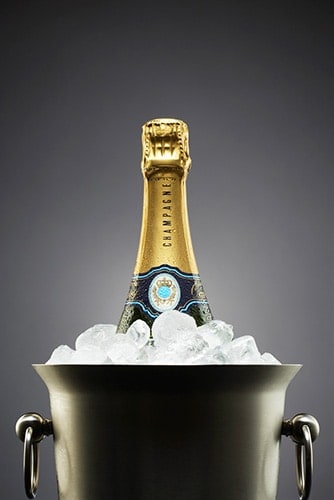How to Store Open Champagne [5 Rules to Save Champagne]

Champagne doesn't really keep well after opening as those delicate carbon dioxide bubbles can quickly disappear.
However, there are a few 'hacks' that can help keep it fresh for longer.
The key is in preserving those precious bubbles. Once that wonderful effervescence is gone, Champagne just isn't worth drinking.
In this guide, I'll show you how to keep Champagne bubbly for longer.
5. Avoid Movement
When storing an open bottle of Champagne think of the bubbles it produces as a finite resource. Every bubble that rises in the bottle is the loss of a tiny bit of effervescence that can't be replaced.
Movement is one of the key reasons that Champagne loses its bubbles. Movement encourages the formation of bubbles, which then rise to the surface and escape from the Champagne. Therefore, once the bottle has been opened, it's best to keep it as still as possible.
Keep Champagne bottles away from sources of vibration and potential bumps, preferably in a cold, dark place as we'll find out.
This also means avoiding the temptation to shake the bottle before opening. You're only wasting Champagne!

4. Keep it Sealed
The fizz in Champagne is produced by lots of carbon dioxide that is dissolved in the liquid. Since the Champagne is under lots of pressure inside the bottle, the carbon dioxide remains dormant.
Once you pop the cork, the high pressure in side the bottle (that keeps the carbon dioxide in the liquid) is released and the carbon dioxide escapes as bubbles. Once all the carbon dioxide is released, there are no more bubbles and your Champagne will no longer fizz.
The only way to apply pressure back to the Champagne that's left in the bottle and preserve some bubbles is by sealing the bottle as quickly as possible after pouring.
By providing an airtight seal you allow pressure to slowly build in the bottle again.
The best way to reseal an opened Champagne bottle is with a dedicated stopper. This needs to be able to clamp on the bottle and provide an airtight seal.
It also needs to be able to withstand the pressure that builds from inside bottle. For this reason, a regular bottle sealer just won't cut it. It's also impossible to recork a Champagne bottle with the original cork.
So, reseal the opened Champagne bottle as soon as possible after each pour. You might read "advice" telling you can use things like foil or plastic wrap to cover the bottle. This may work for very short periods of time but it's not a great solution. A Champagne stopper is the way to go, especially if you drink sparkling wine reasonably regularly.
If you use one of these devices and follow the other best practices then you can keep an opened bottle of Champagne for up to two days. Most people seem to say three days but in my experience, that's really pushing it.
Related: Does unopened Champagne go bad? How long does it keep for?

My Champagne sealer of choice by Le Creuset
3. Keep it Chilled
I've been talking a lot about bubbles and how to keep Champagne bubbly but I'm afraid to say that's not the only fight you've got on your hands!
Champagne has exactly the same weakness to oxygen as still red and white wines. Oxygen in the air causes wine to oxidize becoming dull and lifeless. After enough oxidation, it will lose its fruit flavors and aromas. It will also turn to vinegar as ethanol (alcohol) turns into acetic acid.
This is something that is inevitable for an open bottle of wine. We can't stop this but there are certain things we can do to slow the process down.
Keeping the Champagne cold slows down the oxidation process and also helps to keep the bubbles in the champagne. This is because the solubility of carbon dioxide (which forms the bubbles in Champagne) increases as the temperature decreases. Therefore, a lower temperature will help to keep more carbon dioxide dissolved in the Champagne, preserving the bubbles for longer.
So get your Champagne in the fridge as soon as possible and keep it there.

2. Keep the Bottle Upright
I mentioned oxygen being bad news for wine and another way you can reduce its impact is by keeping your opened Champagne bottle stored upright once resealed.
At all costs resist the temptation to wedge it horizontally into an empty space in the fridge.
This is to reduce the surface area of the Champagne that comes into contact with air. If you have around half a bottle left, the surface area of Champagne that contacts the air is much less in a vertically stored bottle than it is in a bottle on its side. It will see less damaging oxidation because of this.
Related: Learn about the grapes used to make Champagne.
1. Keep it Away From Sunlight
Besides, being a source of heat, sunlight contains damaging ultraviolet light that can cause chemical reactions within wine that produce unpleasant sulphur compounds.
To be honest, your Champagne should be refrigerated by now and far away from sunlight anyway!
Don't Put a Spoon in it! It's a Myth.
An old wives' tale suggests that hanging a spoon in the bottle can help to preserve the bubbles.
However, this method is controversial and lacks any scientific backing. I've heard people say that the metal of the spoon helps to cool the air inside the bottle, reducing the rate at which the carbon dioxide escapes. But, there is zero evidence to back this claim up.
It may help slightly but it's not as effective as following my advice above. Follow these five rules for keeping Champagne fresh and bubbly once opened and you'll give it the best possible chance.
Remember, these methods can help to preserve the bubbles in the Champagne for a while, but they can't prevent the inevitable loss of carbon dioxide over time.
With each rising bubble you lose irreplaceable effervescence and an opened Champagne bottle won't last more than two or three days.
Therefore, it's always best to consume the Champagne as soon as possible after opening the bottle.
